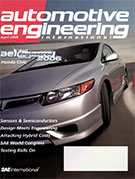Magazine

SAE Off-Highway Engineering: February 5, 2016
2016-02-05
Off-highway hybrids: Opportunities and challenges With oil prices declining and emissions regulations in North America 'stabilized,' is there a place for hybrid powertrains in this new world of cheap oil? Looking for a better image Display advances are helping to reduce operator fatigue. Charging up electrified powertrains Control technologies race forward while batteries improve and adopt standard sizes. Measuring and accounting for suspension TARDEC teamed with SEA Ltd. to develop a system to measure the suspension parameters, center of gravity, and moments of inertia of wheeled vehicles in the never ending quest to model and predict vehicle dynamic behavior. Looking at mobility in 2050 Cuneyt L. Oge begins his term as 2016 SAE International President with a vision about the future of auto- and aero-mobility.



















